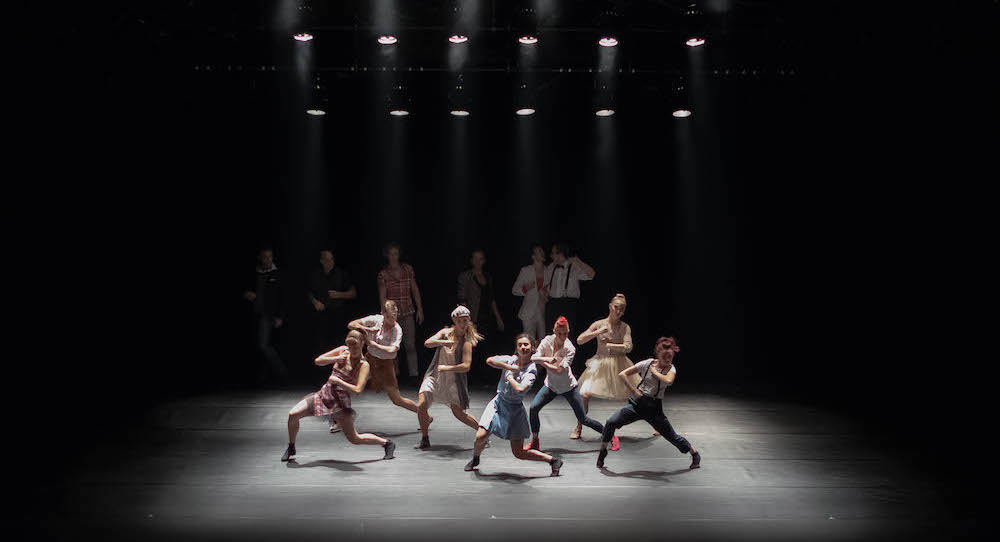Cutler Majestic Theatre, Boston, Massachusetts.
February 2, 2018.
The moving body can be a strikingly beautiful thing. Add on professional dancers’ years of dedicated training and natural abilities, and endless are the possibilities for creating movement of heart-stirring, high-aesthetic caliber. Framed with the complementary elements of music, costuming and lighting, this movement can bolster a theme – one that can uniquely speak to a particular issue in our world, or in the universal human condition. Sometimes, it can create, and then offer, cathartic beauty, valuable in its own right.
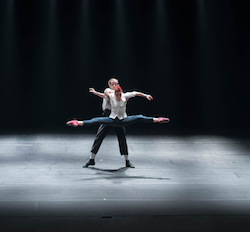
Les Ballets Jazz de Montréal. Photo by Jeremy Coachman.
Countless choreographers can skillfully create and shape aesthetically pleasing movement. The challenge for many can come in structuring this shaping that makes for compelling, meaningful art. Structure is salient. All of this was quite clear in Les Ballets Jazz de Montréal’s recent repertory tour, with three separate pieces performed in Boston. The first piece began with quite successful structure, moving through different groupings of dancers and movement qualities.
Atonal music, yet that with an underlying harmonic layer, accompanied the beginning of the first piece, the world premiere of Itzik Galili’s Casulties of Memory. Backlit dancers (lighting design also by Galili) moved with continuous and curvilinear phrasework. Certain sharper movements, such as upward pulses of “cactus shape” arms, were intriguing accents. In partner and trio work, with jaw-droppingly gorgeous lifts and weight-sharing, there was no struggle or contest of strength.
Whether male or female, dancers moved together harmoniously. A motif was two dancers counter-balancing each other through leaning in opposite directions, legs sometimes grounding and sometimes extending. The program notes alluded to a world of timeless and harmonious gender equality. Interestingly, with all wearing the same costumes (costumes also designed by Galili) and no overtly feminine or masculine movement, there was a compelling sense of androgyny.
Gender didn’t seem apparent or important. In a way, this atmosphere satisfied that intent to build a world of everlasting gender equity. Common humanity far superseded gender. It was all incredibly artful and thoughtful, until it all felt too long. To give praise where it’s due, the movement was spellbinding. The dancers were versatile, strong yet graceful, and 150 percent committed.
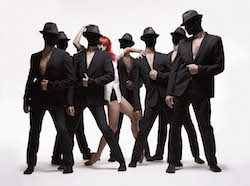
Les Ballets Jazz de Montréal. Photo by Marc Montplaisir.
From a perspective of high standards, based on the success of this movement and the way Galili shaped it in groupings and formations in the stage space, this last third of the piece needed paring down. It came to feel superfluous and repetitive. Writers can have trouble “nixing” content that they’ve put thought and energy into creating, and so can choreographers.
Consulting dancers and other choreographers, with an attitude of detachment, can help artists of all types release what isn’t necessary to the success of their work. Nevertheless, the work has much to offer, and much potential to offer even more. Interestingly, the second work, Dance Me (with contributions from various directors and choreographers) had the opposite problem – closing the loop of the (seemingly) intended message and effect.
Granted, the piece for this repertory performance included only excerpts of the full work, perhaps accounting for any feeling of incomplete structure.
Creative diversity strengthened it, with many movement qualities and styles (from Latin to classical ballet vocabulary), as well as lovely live singing and powerful spoken word. Lighting and costuming (lighting design by Cédric Delorme-Bouchard and costume design by Philippe Dubuc) were simple, yet effective and profound. Céline Cassone, a fiery soloist, both in her red hair and her energy, offered precise yet smooth execution of many different types of movement.
Thematic construction took many different turns, or potential overall interpretations, such as from voiceover building character to a feel of a concert (with a group of dancers in full song to a soloist with recorded applause, seemingly at the song). Different vignettes were artful in their own right, filled with those diverse artistic media and movement vocabulary. A structural issue came in lack of linking these vignettes together, to build some sort clear narrative arc. Again, perhaps a challenge with offering excerpts of a longer work.
That considered, the final ending felt lacking in substance and depth. Lights came down on one dancer lifting his partner high, in a quick flash. Perhaps this effect could imply the ephemorality of passionately romantic love, but – all else in the work as it was – this wasn’t a clear conclusion that it built. In fact, one vignette depicted one half of an older couple coping with the soon-to-come passing of his long-time love.
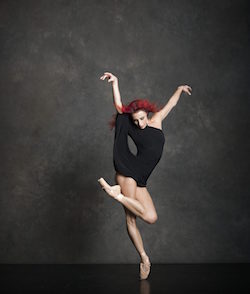
Les Ballets Jazz de Montréal’s Céline Cassone. Photo by Ken Browar and Deborah Ory.
All of that being said, the movement offered much at which the eyes, heart and soul could wonder. The dancers were both technical craftspeople and theatrical heavyweights, filling each movement with authentic emotion (without “overacting” or “ham”). Latin dance footwork was crisp, yet without a hard edge. Instead, it all pleasantly melted into subsequent steps. Smooth floorwork contrasted the lifted quality of this more lifted movement vocabulary.
Sections of dancers improvising in a group, seemingly through a script that could keep it all cohesive and not chaotic, was a refreshing change from the high prevalence of unison in the first piece. Many of the lifts were the kind at which audiences gasp, then clap – those seemingly defiant of gravity and the limits of human strength. One dancer balanced on nothing broader or more stable than the side of partner’s neck, for instance. All of this being so high-caliber, one desired structure and coherence of theme to be just as strong.
Galili also choreographed and designed the third and last piece of the night, O Balcao de Amor, inspired by the music and creative energy he encountered during his time in Cuba. It started humorously, with one macho man (or a man trying to be one) trying to be in a spotlight – and the spotlight wandering elsewhere, like it had a mind of its own. The audience joyfully chuckled. A friend joined him, and they began to dance – joined in movement by yet more fellow dancers.
Eventually, the large cast, each dancer in a unique costume and seemingly a unique character, were moving together all across the stage. Big, bold and fun Latin-inspired movement filled the stage and then ricocheted off the back of the house. The energy and pure joy was everywhere. Balletic touches – such as arms in fifth position en haut, as well as jazzy footwork and extensions, salt-and-peppered the Latin-style movement.
The fast, jumpy music – evidently old-time Cuban jazz-inspired – underlaid, but perhaps also drove ahead, the movement. Daring leaps – such as a dancer leaping across the backs of a line fellow dancers in flat back, to be caught in extension by another dancer – were jaw-dropping feats of physicality and physics. Even with these tricks, everything combined to feel incredibly authentic, a moment of time in Cuba, captured in dance.
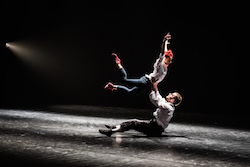
Les Ballets Jazz de Montréal. Photo by Svetla Atanasova.
The nation has fascinated many people for the same reason, how it seems to be caught in time (due to socio-political forces leading it to be isolated from modern technologies and general consumerism). The work seemed to honor all of this – while not political, not trying to explain anything, but only offering authenticity and fun. As part of this feel, A Latin sultriness imbued the movement and supporting artistic media More prevalent, however, were humor and joy.
“Qui sas?”, the dancers called out. It was a party for sure. The party began to wind down, dancers leaving and one dancer annoyed that they had all left him without indicating their plan. One dancer came back out, and the two offered a duet – sultry, funny and heartwarming all at the same time. The cast rejoined them to nail down one last section.
Because of context, and without necessarily the effort to establish a theme, this structure made sense. It was satisfying as one good old time in a specific place on this Earth. This, combined with the two former pieces, demonstrated the salience of structure. Beautiful, powerful movement is one thing. How one successfully structures it all together is another. The best dance art has them both.
By Kathryn Boland of Dance Informa.


